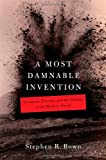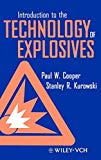Dynamite
 Dynamite is an explosive material consisting of a pure explosive and an absorbent filler material which acts to stabilize the explosive and reduce unexpected detonations.
Dynamite is an explosive material consisting of a pure explosive and an absorbent filler material which acts to stabilize the explosive and reduce unexpected detonations.
The explosive in dynamite is either nitroglycerine alone or nitroglycerine mixed with ammonium nitrate.
The filler material in dynamite is either a finely powdered silicon-based absorbent made from diatomaceous earth called Kieselguhr or a mixture of sawdust and sodium nitrate.
The liquid explosive is absorbed by the filler material. The dynamite is then packaged into sticks approximately eight inches long and an inch in diameter.
Dynamite is relatively inexpensive and yet powerful enough for use in commercial explosives work.
The explosive liquid in dynamite will sometimes coalesce on the surface of the stick. This is called sweating. Sweating can be reduced by storing dynamite in a cool location.
Sweating can also be forced to happen by boiling the dynamite and collecting the nitroglycerine as it floats on the boiling water. Don’t try that one at home.
Unlike pure nitroglycerine, dynamite is a relatively safe explosive. Dynamite is insensitive to shock, friction, and impact.
Dynamite is usually detonated with a blasting cap.
Dynamite was invented in 1867 by Alfred Nobel.
The Dynamite Patent
Nobel patented Dynamite in U.S. Patent 78317: Improved Explosive Compound.
Books on Dynamite

A Most Damnable Invention : Dynamite, Nitrates, and the Making of the Modern World
Stephen Bown follows his well-received Scurvy with another sedulously researched and well-written popular history. He’s particularly good at penning provocative theories that link seemingly modest events to monumental changes in the course of history. For example, prior to the Franco-Prussian War, the French government, unlike Prussia, refused to allow its munitions experts to develop weaponry utilizing Alfred Nobel’s powerful new explosive, dynamite. The result, according to Bown, was a humiliating defeat that forced the French to submit to onerous treaty terms that helped set the stage for WWI. Bown’s knowledge of his subject is impressive, and he has interesting things to say about the science and scientists central to the development of explosives; the role these explosives played in Japan, China and India; and positive changes facilitated by the use of high explosives in mining and construction. Bown also has a good eye for the unintended consequences, ironies and contradictions that are the product of social and technological forces of great magnitude. That Alfred Nobel used the proceeds of his vast munitions fortune to fund the Nobel Prizes is perhaps the ultimate example.

Introduction to the Technology of Explosives
Introduction to the Technology of Explosives Paul W. Cooper and Stanley R. Kurowski Introduction to the Technology of Explosives is a clear and concise survey of the technologies and physical processes involved in explosive phenomena. The book is intended to provide the worker new to the field with sufficient background to understand problems that may arise and to interact intelligently with specialists in the field. The book covers the fundamentals of the chemistry of explosives; the mechanics of burning; sound, shock, and detonation; initiation and initiators; scaling in design and analysis; and off-the-shelf explosive devices. It provides the basic calculational skills needed to solve simple, first-order engineering design problems, and emphasizes the crucial importance of safety considerations. The book contains a broad range of data on explosive materials, and their properties and behavior, along with extensive lists of useful references. Example problems with solutions are provided in each technical area, as are descriptions and analysis of a wide variety of explosive devices. The book concludes with a thorough and comprehensive description of regulatory requirements for the classification, transportation, and storage of explosives, and an extensive guide to explosives safety in plant and test facilities. This book will be of interest to explosives technicians and engineers, government regulators, crime and accident scene investigators, and instructors in military, police, and FBI bomb schools.

Home Workshop Explosives, Second Edition
This book earns the title! Over the course of 172 pages, I have taken all of the great material in the first edition and added to it a series of recipes and procedures which produce military grade explosives from commonplace items and materials. In doing so, I conclusively prove that the restrictions which have been placed upon the access to the commercially produced explosives which were so freely available in my youth are all futile. The real enemies in “the war on terror” are not inanimate objects such as explosives. The real enemies are the politicians who have flung open our borders to infiltration by Moslem guerrillas. These guerrillas are already well versed in the techniques of improvised weaponry manufacture.
This treasure trove of explosive information features The Hardware Store Nitro Recipe, Fuel/Air Explosives, military equivalent ammonium nitrate formulations, nitromethane mixtures, and a vastly improved detonator section.
The expose`of the folly of our present policies doesn’t stop there either! Read all about the construction of remote control cruise missiles and RC torpedoes. Claymore mines and air cannons add spice to the stew. Then top it all off with my commentary on the easiest ways to obtain all the materials mentioned in the book.
I’ve read all the books on the topic of explosives from tiny paperbacks to 600 page texts written by PhDs. I have no hesitation saying this book tops them all! It’s my hope that when you finish reading this book, politicians will no longer be able to fool or distract you by blaming an inanimate object such as explosives for the direct results of their disastrous policies.